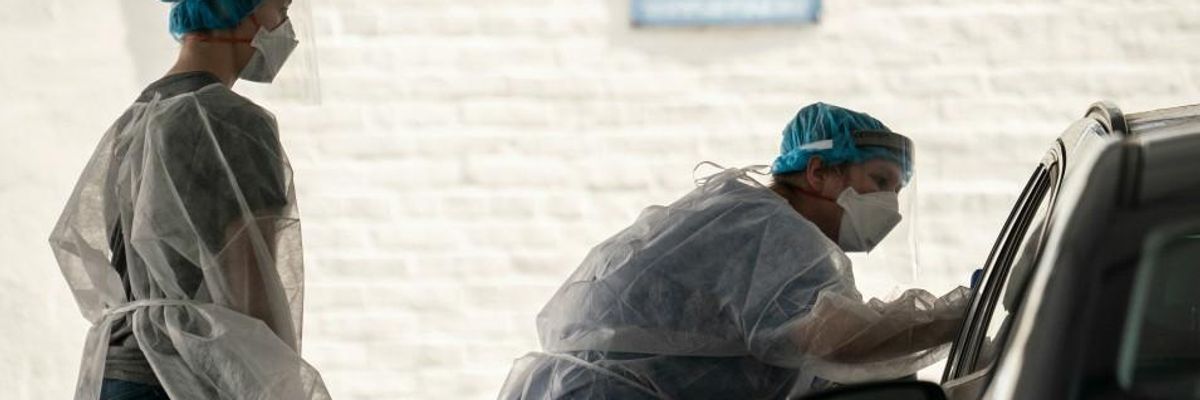
A medical professional administers a coronavirus test at a drive-thru testing site run by George Washington University Hospital, May 26, 2020 in Washington, D.C. (Photo: Drew Angerer/Getty Images)
Despite Trump Claim, Research Shows US Covid-19 Testing Rate Just 39% of Level Needed
The U.S. would have to double its daily testing rate in order to control the coronavirus, and even more testing would be needed to suppress the outbreak.
President Donald Trump has claimed that testing in the United States for the coronavirus is "the best in the world" and has even suggested there is too much testing.
But the "short answer" to a New York Times' headline asking on Friday, "Is Your State Doing Enough Coronavirus Testing?" is that moststates are not, the director of the Harvard Global Health Institute said Friday.
According to researchers at the institute and the Covid Tracking Project, the number of daily coronavirus tests being conducted in the U.S. is only 39% of the target rate needed to mitigate the spread of the virus.
Without a standardized federal testing strategy, states have been left to procure and administer tests themselves, leaving some of the hardest-hit states testing at some of the lowest rates in the nation.
Just 12 states--Maine, Vermont, New York, Connecticut, Massachusetts, New Jersey, Alaska, Hawaii, West Virginia, Montana, Kansas, and Washington, D.C.--are testing at the optimal rate, the Times reported. Five states are approaching the target, but the vast majority of states--34 overall--are "far below" the target rate.
Nationwide, the U.S. tested 634,000 people per day in the last week. According to epidemiologists at Harvard, with an outbreak as large as the one in the United States, 1.6 million people must be tested per day to mitigate the virus. Suppressing the virus, as New Zealand, Iceland, and Vietnam have, would take far more daily tests.
Trump has repeatedly bragged about the nation's testing regiment but called for the testing rate to be slowed down or halted, falsely claiming that more testing is the reason for an increased infection rate. On Wednesday, a Republican state lawmaker in Ohio pleaded with constituents to "stop getting tested!" and claimed that doing so is "giving the government an excuse to claim something is happening that is not happening at the magnitude they say it is happening."
"We aren't doing too much testing," said Ashish Jha, director of the Harvard Global Health Institute. "We're doing too few."
\u201cIs your state doing enough testing?\n\nGreat to have @collinskeith use our @harvardgh approach\n\nShort answer: 39 states don't meet basic testing target\n\nA few are close\n\nMost are far, far away\n\nWe aren't doing too much testing. We are doing too few\n\nhttps://t.co/bNYgci40sg\u201d— Ashish K. Jha, MD, MPH (@Ashish K. Jha, MD, MPH) 1594390880
To meet the level of testing recommended by Harvard experts, the U.S. would have to double its daily rate, the Times reported.
"At minimum there should be enough daily capacity to test anyone who has flu-like symptoms and an additional 10 people for any symptomatic person who tests positive for the virus," wrote Keith Collins at the Times.
Epidemiologist Abdul El-Sayed pointed out that the U.S. has "been at this since February" but still lags behind several other countries in its testing capacity, despite having the world's largest outbreak of Covid-19.
\u201cWe are doing 39% of the amount of testing that we need to mitigate the spread of #COVID19...\n\nand we've been at this since February.\u201d— Dr. Abdul El-Sayed (@Dr. Abdul El-Sayed) 1594395264
While the U.S. has performed more total tests than any other country, Trump's claim that "America leads the world in testing" is inaccurate based on the per-capita rate of testing, according to FactCheck.org.
Denmark has tested more people per capita than any other country as of July 9. Russia, Israel, Iceland, and Australia have also tested far more people per 1,000 residents than the United States.
FactCheck.org also pointed out that the U.S. fell far behind other countries in the crucial early weeks of the pandemic. South Korea was lauded for its testing capacity in early March, when it was testing 10,000 people per day. At the time, the U.S. provided no public information about how many people it was testing. The U.S. only reached South Korea's daily testing capacity on April 15, when South Korea's case numbers had already begun to fall dramatically.
"Economic researchers at the Federal Reserve Bank of St. Louis noted in an April 22 paper that South Korea's early testing 'seems to have paid off,' while U.S. 'inaction' resulted in more confirmed COVID-19 cases," wrote Lori Robertson and Eugene Kiely at FactCheck.org.
An Urgent Message From Our Co-Founder
Dear Common Dreams reader, The U.S. is on a fast track to authoritarianism like nothing I've ever seen. Meanwhile, corporate news outlets are utterly capitulating to Trump, twisting their coverage to avoid drawing his ire while lining up to stuff cash in his pockets. That's why I believe that Common Dreams is doing the best and most consequential reporting that we've ever done. Our small but mighty team is a progressive reporting powerhouse, covering the news every day that the corporate media never will. Our mission has always been simple: To inform. To inspire. And to ignite change for the common good. Now here's the key piece that I want all our readers to understand: None of this would be possible without your financial support. That's not just some fundraising cliche. It's the absolute and literal truth. We don't accept corporate advertising and never will. We don't have a paywall because we don't think people should be blocked from critical news based on their ability to pay. Everything we do is funded by the donations of readers like you. Will you donate now to help power the nonprofit, independent reporting of Common Dreams? Thank you for being a vital member of our community. Together, we can keep independent journalism alive when it’s needed most. - Craig Brown, Co-founder |
President Donald Trump has claimed that testing in the United States for the coronavirus is "the best in the world" and has even suggested there is too much testing.
But the "short answer" to a New York Times' headline asking on Friday, "Is Your State Doing Enough Coronavirus Testing?" is that moststates are not, the director of the Harvard Global Health Institute said Friday.
According to researchers at the institute and the Covid Tracking Project, the number of daily coronavirus tests being conducted in the U.S. is only 39% of the target rate needed to mitigate the spread of the virus.
Without a standardized federal testing strategy, states have been left to procure and administer tests themselves, leaving some of the hardest-hit states testing at some of the lowest rates in the nation.
Just 12 states--Maine, Vermont, New York, Connecticut, Massachusetts, New Jersey, Alaska, Hawaii, West Virginia, Montana, Kansas, and Washington, D.C.--are testing at the optimal rate, the Times reported. Five states are approaching the target, but the vast majority of states--34 overall--are "far below" the target rate.
Nationwide, the U.S. tested 634,000 people per day in the last week. According to epidemiologists at Harvard, with an outbreak as large as the one in the United States, 1.6 million people must be tested per day to mitigate the virus. Suppressing the virus, as New Zealand, Iceland, and Vietnam have, would take far more daily tests.
Trump has repeatedly bragged about the nation's testing regiment but called for the testing rate to be slowed down or halted, falsely claiming that more testing is the reason for an increased infection rate. On Wednesday, a Republican state lawmaker in Ohio pleaded with constituents to "stop getting tested!" and claimed that doing so is "giving the government an excuse to claim something is happening that is not happening at the magnitude they say it is happening."
"We aren't doing too much testing," said Ashish Jha, director of the Harvard Global Health Institute. "We're doing too few."
\u201cIs your state doing enough testing?\n\nGreat to have @collinskeith use our @harvardgh approach\n\nShort answer: 39 states don't meet basic testing target\n\nA few are close\n\nMost are far, far away\n\nWe aren't doing too much testing. We are doing too few\n\nhttps://t.co/bNYgci40sg\u201d— Ashish K. Jha, MD, MPH (@Ashish K. Jha, MD, MPH) 1594390880
To meet the level of testing recommended by Harvard experts, the U.S. would have to double its daily rate, the Times reported.
"At minimum there should be enough daily capacity to test anyone who has flu-like symptoms and an additional 10 people for any symptomatic person who tests positive for the virus," wrote Keith Collins at the Times.
Epidemiologist Abdul El-Sayed pointed out that the U.S. has "been at this since February" but still lags behind several other countries in its testing capacity, despite having the world's largest outbreak of Covid-19.
\u201cWe are doing 39% of the amount of testing that we need to mitigate the spread of #COVID19...\n\nand we've been at this since February.\u201d— Dr. Abdul El-Sayed (@Dr. Abdul El-Sayed) 1594395264
While the U.S. has performed more total tests than any other country, Trump's claim that "America leads the world in testing" is inaccurate based on the per-capita rate of testing, according to FactCheck.org.
Denmark has tested more people per capita than any other country as of July 9. Russia, Israel, Iceland, and Australia have also tested far more people per 1,000 residents than the United States.
FactCheck.org also pointed out that the U.S. fell far behind other countries in the crucial early weeks of the pandemic. South Korea was lauded for its testing capacity in early March, when it was testing 10,000 people per day. At the time, the U.S. provided no public information about how many people it was testing. The U.S. only reached South Korea's daily testing capacity on April 15, when South Korea's case numbers had already begun to fall dramatically.
"Economic researchers at the Federal Reserve Bank of St. Louis noted in an April 22 paper that South Korea's early testing 'seems to have paid off,' while U.S. 'inaction' resulted in more confirmed COVID-19 cases," wrote Lori Robertson and Eugene Kiely at FactCheck.org.
President Donald Trump has claimed that testing in the United States for the coronavirus is "the best in the world" and has even suggested there is too much testing.
But the "short answer" to a New York Times' headline asking on Friday, "Is Your State Doing Enough Coronavirus Testing?" is that moststates are not, the director of the Harvard Global Health Institute said Friday.
According to researchers at the institute and the Covid Tracking Project, the number of daily coronavirus tests being conducted in the U.S. is only 39% of the target rate needed to mitigate the spread of the virus.
Without a standardized federal testing strategy, states have been left to procure and administer tests themselves, leaving some of the hardest-hit states testing at some of the lowest rates in the nation.
Just 12 states--Maine, Vermont, New York, Connecticut, Massachusetts, New Jersey, Alaska, Hawaii, West Virginia, Montana, Kansas, and Washington, D.C.--are testing at the optimal rate, the Times reported. Five states are approaching the target, but the vast majority of states--34 overall--are "far below" the target rate.
Nationwide, the U.S. tested 634,000 people per day in the last week. According to epidemiologists at Harvard, with an outbreak as large as the one in the United States, 1.6 million people must be tested per day to mitigate the virus. Suppressing the virus, as New Zealand, Iceland, and Vietnam have, would take far more daily tests.
Trump has repeatedly bragged about the nation's testing regiment but called for the testing rate to be slowed down or halted, falsely claiming that more testing is the reason for an increased infection rate. On Wednesday, a Republican state lawmaker in Ohio pleaded with constituents to "stop getting tested!" and claimed that doing so is "giving the government an excuse to claim something is happening that is not happening at the magnitude they say it is happening."
"We aren't doing too much testing," said Ashish Jha, director of the Harvard Global Health Institute. "We're doing too few."
\u201cIs your state doing enough testing?\n\nGreat to have @collinskeith use our @harvardgh approach\n\nShort answer: 39 states don't meet basic testing target\n\nA few are close\n\nMost are far, far away\n\nWe aren't doing too much testing. We are doing too few\n\nhttps://t.co/bNYgci40sg\u201d— Ashish K. Jha, MD, MPH (@Ashish K. Jha, MD, MPH) 1594390880
To meet the level of testing recommended by Harvard experts, the U.S. would have to double its daily rate, the Times reported.
"At minimum there should be enough daily capacity to test anyone who has flu-like symptoms and an additional 10 people for any symptomatic person who tests positive for the virus," wrote Keith Collins at the Times.
Epidemiologist Abdul El-Sayed pointed out that the U.S. has "been at this since February" but still lags behind several other countries in its testing capacity, despite having the world's largest outbreak of Covid-19.
\u201cWe are doing 39% of the amount of testing that we need to mitigate the spread of #COVID19...\n\nand we've been at this since February.\u201d— Dr. Abdul El-Sayed (@Dr. Abdul El-Sayed) 1594395264
While the U.S. has performed more total tests than any other country, Trump's claim that "America leads the world in testing" is inaccurate based on the per-capita rate of testing, according to FactCheck.org.
Denmark has tested more people per capita than any other country as of July 9. Russia, Israel, Iceland, and Australia have also tested far more people per 1,000 residents than the United States.
FactCheck.org also pointed out that the U.S. fell far behind other countries in the crucial early weeks of the pandemic. South Korea was lauded for its testing capacity in early March, when it was testing 10,000 people per day. At the time, the U.S. provided no public information about how many people it was testing. The U.S. only reached South Korea's daily testing capacity on April 15, when South Korea's case numbers had already begun to fall dramatically.
"Economic researchers at the Federal Reserve Bank of St. Louis noted in an April 22 paper that South Korea's early testing 'seems to have paid off,' while U.S. 'inaction' resulted in more confirmed COVID-19 cases," wrote Lori Robertson and Eugene Kiely at FactCheck.org.

